The .256 Winchester Magnum is a firearms cartridge developed by Winchester, and was produced by necking-down a .357 Magnum cartridge to .257 diameter. It was designed for shooting small game and varmints.

The .460 Weatherby Magnum is a belted, bottlenecked rifle cartridge, developed by Roy Weatherby in 1957. The cartridge is based on the .378 Weatherby Magnum necked up to accept the .458-inch (11.6 mm) bullet. The original .378 Weatherby Magnum parent case was inspired by the .416 Rigby. The .460 Weatherby Magnum was designed as an African dangerous game rifle cartridge for the hunting of heavy, thick skinned dangerous game.

A wildcat cartridge, often shortened to wildcat, is a custom cartridge for which ammunition and/or firearms are not mass-produced. These cartridges are often created in order to optimize a certain performance characteristic of an existing commercial cartridge, or may merely be intended as novelty items.
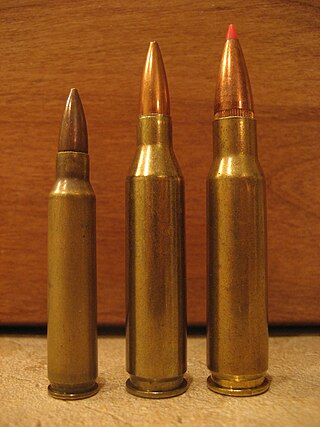
The .243 Winchester (6×52mm) is a popular sporting rifle cartridge. Developed as a versatile short action cartridge to hunt both medium game and small game alike, it "took whitetail hunting by storm" when introduced in 1955, and remains one of the most popular whitetail deer cartridges. It is also commonly used for harvesting blacktail deer, pronghorns and mule deer with heavier rounds, and is equally suited to varmint hunting with lighter rounds. The .243 is based on a necked down .308 Winchester, introduced only three years earlier. Expanding monolithic copper bullets of approximately 80 to 85 grains or traditional lead rounds of 90 to 105 grains with controlled expansion designs are best suited for hunting medium game, while lighter rounds are intended for varmints.
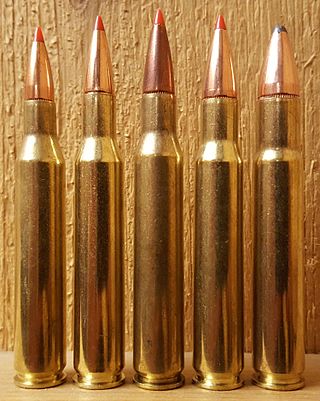
The .270 Winchester is a rifle cartridge developed by Winchester Repeating Arms Company in 1923, and it was unveiled in 1925 as a chambering for their bolt-action Model 54 to become arguably the flattest shooting cartridge of its day, only competing with the .300 Holland & Holland Magnum, also introduced in the same year.
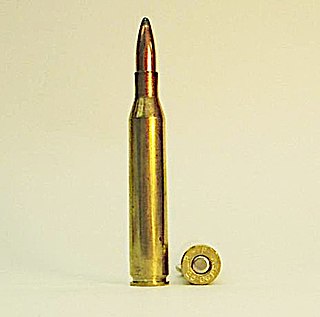
Considered by many as the most balanced of the "quarter bores" for hunting medium-sized game, the .25-06 Remington remained in obscurity as a wildcat cartridge for nearly half a century before being standardized by Remington in 1969.

.17 Hornady Magnum Rimfire, commonly known as the .17 HMR, is a rimfire rifle cartridge developed by Hornady in 2002. It was developed by necking down a .22 Winchester Magnum Rimfire case to take a .17 caliber (4.5mm) projectile. Commonly loaded with a 17 grain projectile, it can deliver muzzle velocities in excess of 775 m/s.
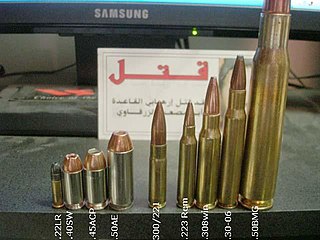
The .300 Whisper (7.82x34mm) is a CIP standard cartridge in the Whisper family, a group of cartridges developed in the early 1990s by J.D. Jones of SSK Industries. It was developed as a multi-purpose cartridge, capable of utilizing relatively lightweight bullets at supersonic velocities as well as heavier bullets at subsonic velocities.
The .204 Ruger is a centerfire rifle cartridge developed by Hornady and Ruger. At the time of its introduction in 2004, the .204 Ruger was the second-highest velocity commercially produced ammunition and the only centerfire cartridge produced commercially for bullets of .204 inch/5 mm caliber.

The .444 Marlin (10.9×57mmR) is a rifle cartridge designed in 1964 by Marlin Firearms and Remington Arms. It was designed to fill in a gap left by the older .45-70 when that cartridge was not available in any new lever-action rifles; at the time it was the largest lever-action cartridge available. The .444 resembles a lengthened .44 Magnum and provides a significant increase in velocity. It is usually used in the Marlin 444 lever-action rifle. Currently, Marlin, who is now owned by Ruger Firearms, does not offer the .444 chambering in any of their rifles. It remains to be seen when or if they will bring the chambering back into production.

The .338 Winchester Magnum is a .338 in (8.6 mm) caliber, belted, rimless, bottlenecked cartridge introduced in 1958 by Winchester Repeating Arms. It is based on the blown-out, shortened .375 H&H Magnum. The .338 in (8.6 mm) is the caliber at which medium-bore cartridges are considered to begin. The .338 Winchester Magnum is the first choice among professional brown bear guides in Alaska to back up clients where a powerful stopping caliber is required on charging bears. It is also the most popular medium-bore cartridge in North America and has the most widely available choice in rifles among medium bore rifles. The action length is the same as a .30-06, and most major rifle manufacturers in the United States chamber rifles for the cartridge including the semi-automatic Browning BAR Mk II Safari, making it a very powerful combination against charging dangerous game. The cartridge was intended for larger North American big-game species and has found use as for the hunting of thin-skinned African plains-game species.

The .220 Swift (5.56×56mmSR) is a semi-rimmed rifle cartridge developed by Winchester and introduced in 1935 for small game and varmint hunting. It was the first factory-loaded rifle cartridge with a muzzle velocity of over 1,200 m/s (4,000 ft/s).

The .222 Remington or 5.7×43mm (C.I.P), also known as the triple deuce, triple two, and treble two, is a centerfire rifle cartridge. Introduced in 1950, it was the first commercial rimless .22 (5.56 mm) cartridge made in the United States. As such, it was an entirely new design, without a parent case. The .222 Remington was a popular target cartridge from its introduction until the mid-1970s and still enjoys a reputation for accuracy. It remains a popular vermin or "varmint" cartridge at short and medium ranges with preferred bullet weights of 40–55 grains and muzzle velocities from 3,000 to 3,500 ft/s (915–1,067 m/s).

The 6mm Remington rifle cartridge, originally introduced in 1955 by Remington Arms Company as the .244 Remington, is based on a necked down .257 Roberts cartridge using a .24/6mm bullet. Known for a combination of high velocity, long range, flat trajectory, and accuracy, it is suitable as a dual use hunting cartridge for both medium-sized big game and varmints. When used in the less common earlier slow twist barrels, it offers exceptional range for varmint applications. While not as commercially popular today as the .243 Winchester, the 6mm Remington enjoys a slight ballistic advantage and continues to be popular with handloaders and custom rifle builders.

The .257 Roberts, also known as .257 Bob, is a medium-powered .25 caliber rifle cartridge. It has been described as the best compromise between the low recoil and flat trajectory of smaller calibers such as the 5 mm and 6 mm, and has more energy, but is harder recoiling, similar to larger hunting calibers, such as the 7 mm and 7.62 mm.

The .416 Remington Magnum is a .416 caliber (10.57 mm) cartridge of belted bottlenecked design. The cartridge was intended as a dangerous game hunting cartridge and released to the public in 1989. The cartridge uses the case of the 8 mm Remington Magnum as a parent cartridge. When the cartridge was released in 1988, author Frank C. Barnes considered the .416 Remington Magnum to be the "most outstanding factory cartridge introduced in decades".
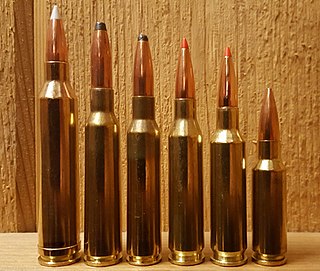
The 6.5mm Creedmoor (6.5×48mm), designated 6.5 Creedmoor by SAAMI, 6.5 Creedmoor by the C.I.P. or 6.5 CM or 6.5 CRDMR for short, is a centerfire rifle cartridge introduced by Hornady in 2007. It was developed by Hornady senior ballistics scientist Dave Emary in partnership with Dennis DeMille, the vice-president of product development at Creedmoor Sports, hence the name. The cartridge is a necked-down modification of the .30 Thompson Center.
The 6×45mm is a rimless, bottlenecked cartridge based on the .223 Remington or 5.56 NATO cartridge necked up to .243 (6mm). The cartridge is also known as the 6mm-223 Remington or 6mm/223.

A varmint rifle is a small-caliber precision firearm or high-powered airgun primarily used for both varmint hunting and pest control. These tasks include killing three types of pests or nuisance animals that spread diseases or destroy crops or livestock:
The .277 Wolverine (6.8x39mm) is a wildcat cartridge. It is a multi-purpose mid-power cartridge with increased ballistic performance over the AR-15's traditional .223 Remington cartridge. The use of a modified 5.56 case means that at minimum, only a new barrel is needed to convert any 5.56-based firearm to .277 Wolverine.
















